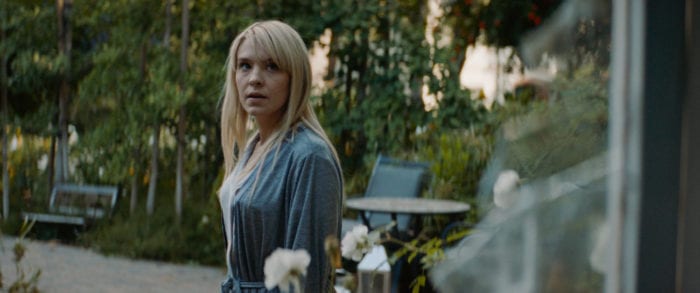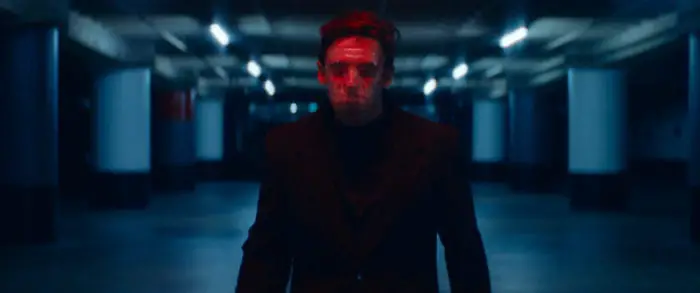Director Natasha Kermani skillfully dissects the slasher genre in her sophomore feature, Lucky (2020), a Shudder Original available for streaming on March 4. Coming off of her impressive feature debut (2017’s Imitation Girl, which debuted at FrightFest and is currently streaming for free on Tubi TV), Kermani’s new film is a slasher satire that drops the viewer in a murderous time loop that is sure to lead them towards introspection.
May (Brea Grant, who also wrote the film) and Ted (Dhruv Uday Singh) are married and share a seemingly happy life together. Then one night, May sees a terrifying man in a mask on their lawn. She wakes up her husband and frantically tells him what she saw, to which he nonchalantly responds, “That’s the man who comes every night to try and kill us.”
The true horror in the film comes not from “The Man” who tries to kill May every night—though Kermani is sure to include a handful of shots that will give Carpenter fans a warm, fuzzy feeling inside—but from the responses that she gets from others after each attack. The police are ineffective in preventing the attacks and quickly begin to question her sanity, as does her husband, and the women surrounding her seem distracted or uninterested in her supernatural problem.
The “final girl” in horror cinema has become a well-known and oft-expected trope of the genre. Ripley of Alien (1979), Laurie of Halloween (1978), and Jess of Black Christmas (1974) are three iconic examples of characters that helped solidify the role of the final girl not just in the horror community but throughout American pop culture.
For those unfamiliar with the trope—which is likely nobody, but I ask that you humor me for a paragraph—the final girl is most commonly found in the slasher genre and is typically the lone survivor of the film. Though it has been lauded as a feminist construct because it champions a female protagonist and usually centers around a strong, independent woman, there are still obvious ties to patriarchy. Female death in horror films usually is connected to promiscuity and is blamed on the victim rather than the murderer, and Kermani’s film is eager to shine a light on why we deem these deaths justified.
We’ve reached the point where the final girl has now been parodied and subverted in many films, including Cabin in the Woods (2011) and Scream (1996). These films have a meta-textual understanding of what it is to be a final girl and play with or against those expectations. There are also a handful of films like Final Girl (2015) that wear the trope like a badge of honor and often dive into the revenge genre to create catharsis for the countless female victims that we have seen fall at the hands of monstrous men.
And this is where Lucky stands alone. It is a film that is not satisfied with simply regurgitating the same victim-versus-attacker narrative. It aims to fully dissect the narratives that film and society tell regarding toxic masculinity and our response to it. In similar fashion to Boots Riley’s Sorry to Bother You, the high-concept horror presented in the film exists equally in both the metaphorical and the real world effectively, and there is a clear humanitarian message that is at the forefront of its story.
When Ted gives his casual response to the first home invasion, May’s sense of trust in her partner and society is shattered. She attempts to write off her interaction with the masked man and the police by telling herself it was all a dream, but the next morning, a broken window and Ted confirm that it was very real and would keep happening.

Though Ted continues to have a nonchalant attitude towards the home invasions, May understandably demands more explanation for this heinous act. And as she attempts to pry more information from Ted, he grows frustrated and storms out of the house. At her most desperate time, May is abandoned and forced to fend for herself, and that betrayal is designed to arouse more fear than the actual attacks we are shown throughout the remainder of the story.
In fact, a large part of the violence in Lucky comes from May as she consistently fends off her attacker. The typical formula for a final girl film includes a third act in which the heroine meets the antagonist face to face (or mask) and bests them either physically or mentally. May has reached this final form near the beginning of the film, and so instead we are shown the psychological damage that is inflicted when someone is forced to internalize daily attacks without a support system.

The fights between May and The Man feel like a nightmare, one where no matter how hard you kick or punch at a foe, nothing seems to deter their path in the dream state. This nightmarish figure robs her of any solace she could possibly have while being alone in what should be a safe place and then taints her waking life by marking her as a troubled person when she reaches out for help.
It’s established early on that May is a successful self-help blogger and author whose career is currently in a slump. As the nightly attacks continue, May begins to doubt her self-worth, causing her work to suffer. Eventually, her flawless facade begins to crack, and the title of her book, Go It Alone, takes on a sinister meaning.
In truth, the overt morality of the piece at times limits the effectiveness of the narrative, but it also seems like a conscious choice from Kermani. And though the film didn’t exactly earn its 83-minute runtime, it is absolutely the kind of film that is worth supporting.
So when it comes to whether you should see this movie or not, I’m glad to say that this movie earns an “IT’S ALIVE” from this reviewer.
It’s a unique addition to the home-invasion/slasher genre and an inspiring piece of art from a promising young director. Slasher flicks have long been praised for their campy fun, but now it’s time to take off the mask and acknowledge the dark realities of a society that delights in violence towards women.
In the year 2021, feminist horror fans shouldn’t consider themselves lucky just to have a female protagonist, not when there are talented directors and writers like Natasha Kermani and Brea Grant around to bring fresh takes on the genre.


